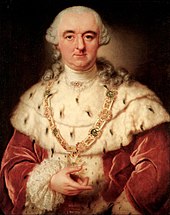art.wikisort.org - Museum
The Reiss Engelhorn Museum, or Reiss-Engelhorn-Museen (rem for short), is a museum in Mannheim, Germany. It has an exhibition area of 11,300 square metres (122,000 sq ft), and houses around 1.2 million objects.[1]
Reiss-Engelhorn-Museen | |
 | |
 | |
| Location | Mannheim, Germany |
|---|---|
| Coordinates | 49°29′20″N 8°27′44″E |
| Collection size | ~1.2 million objects |
| Chairperson | Wilfried Rosendahl |
| Website | www |

Facilities and collection
The Reiss-Engelhorn-Museum is one of the major museums in Mannheim and comprises four exhibition halls presenting exhibits in archaeology, world cultures, history of art and culture, photography and history of theater and music.[2]
The main facility is the Zeughaus Museum, which features exhibit areas for art, decorative art and cultural history, theater, literature and antiquities.[3] The International Photography Forum, located on the fourth floor, displays photographs from the permanent collections ranging from 19th century to contemporary works and presents exhibitions.[4]
The World Cultures Museum features displays of archaeology from the Metal Ages up through the Roman era, as well as medieval Germany, and ancient Egyptian art and culture.[5]
The Bassermannhaus Museum of Music and Fine Arts features a large collection of musical instruments from around the world.[6]
The Schillerhaus Museum is an 18th-century house that presents the life of Friedrich Schiller.[7]
Wikimedia lawsuit
In 2015, the museum filed a lawsuit against the Wikimedia Foundation and Wikimedia Deutschland over the use of photographs of public domain artworks on the Wikimedia projects.[8] In June 2016, a Berlin court (Landgericht Berlin) ruled that digitizing paintings that are in the public domain creates new copyrights, even if the intent is to create a faithful image of the public domain work. The lawsuit was dismissed with respect to Wikimedia Deutschland on the basis that it was not responsible for the files which are managed in the U.S. by the Wikimedia Foundation, which latter organization expressed the intent to appeal the decision.[9][10]
In a related case, in May 2017, the Oberlandesgericht of Stuttgart ruled with reference to the concept of property (Sacheigentum).[11] Property is addressed by article 14 of the German constitution.[12] The Stuttgart court ruled that under German law already skill and effort restricts a photo under Lichtbild rules for 50 years, even though no creativity is involved and thus the more elaborate restrictions of a Lichtbildwerk do not apply (70 years pma). The court has allowed an appeal to the Federal Court of Justice (Bundesgerichtshof).[13]
On December 20, 2018, the court decided in favour of the museum.[14]
See also
- National Portrait Gallery and Wikimedia Foundation copyright dispute
References
- "Reiss-Engelhorn-Museen". rem. Retrieved 24 November 2015.
- "Museums and galleries". City of Mannheim. Retrieved 2017-03-15.
- "Zeughaus Museum". rem. Retrieved 2017-03-15.
- "International Photography Forum". rem. Retrieved 2017-03-15.
- "World Cultures Museum". rem. Retrieved 2017-03-15.
- "Bassermannhaus Museum of Music and Fine Arts". rem. Retrieved 2017-03-15.
- "Schillerhaus Museum". rem. Retrieved 2017-03-15.
- "Wikimedia Foundation, Wikimedia Deutschland urge Reiss Engelhorn Museum to reconsider suit over public domain works of art". Wikimedia Foundation. 23 November 2015. Retrieved 24 November 2015.
- Glyn Moody (23 June 2016). "Digitising public domain images creates a new copyright, rules German court". Ars Technica. Retrieved 2016-07-05.
- Landgericht Berlin judgment in the Reiss-Engelhorn Museum v. Wikimedia Foundation case (in German)
- "Gemeinfreiheit versus Eigentum – der Fall Reiss-Engelhorn-Museen". right Anwaltskanzlei (in German).
Zum Sacheigentum an einer beweglichen Sache gehört ebenfalls die Befugnis, andere vom Zugang und der Besichtigung der Sache auszuschließen und diese zu reglementieren (so kann z.B. der Eigentümer eines Monet frei entscheiden, ob nur er das Bild anschaut oder auch andere Zugang haben, wenn ja, in welcher Weise, ob und wie er das Bild nutzt oder ob er es gar umgestaltet oder zerstört).
- Gregory S., Alexander (March 2003). "Property as a Fundamental Constitutional Right? The German Example". Cornell Law Faculty Working Papers.
- Glyn Moody (16 June 2017). "Multiple German Courts Rule Photos Of Public Domain Works Are Not In The Public Domain". Techdirt. Retrieved 2017-11-24.
- "Pressemitteilung Nr. 195/18 vom 20.12.2018".
External links
На других языках
[de] Reiss-Engelhorn-Museen
Die Reiss-Engelhorn-Museen (Abkürzung in Eigenschreibweise: rem) sind ein in Mannheim ansässiger Museumsverbund, der mehrere dortige Museen, Kulturinstitute und Forschungseinrichtungen betreibt.[8] Sie sind ein kommunaler Eigenbetrieb der Stadt Mannheim.[9] Die Reiss-Engelhorn-Museen werden umfassend durch die gemeinnützige rem gGmbH unterstützt, in der mehrere Stiftungen zur Förderung der Reiss-Engelhorn-Museen zusammengeschlossen sind.[10]- [en] Reiss Engelhorn Museum
Другой контент может иметь иную лицензию. Перед использованием материалов сайта WikiSort.org внимательно изучите правила лицензирования конкретных элементов наполнения сайта.
WikiSort.org - проект по пересортировке и дополнению контента Википедии